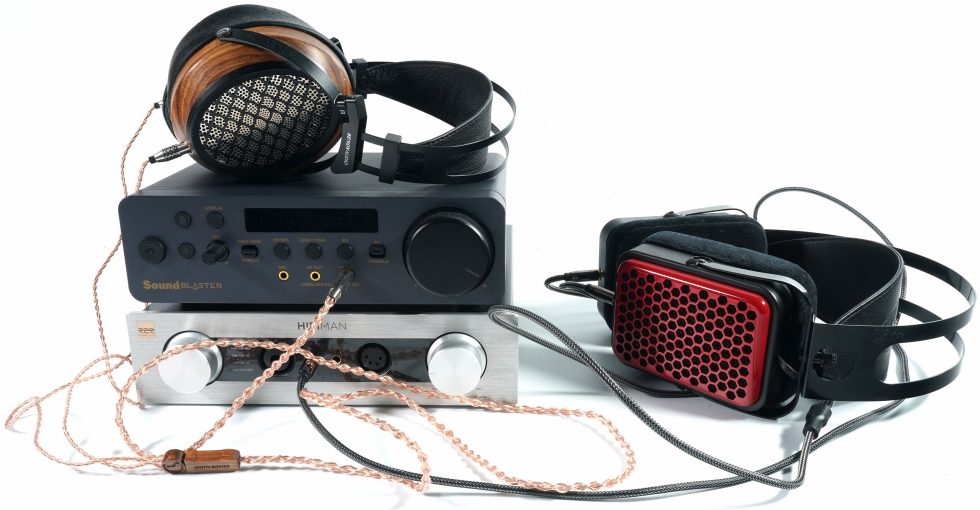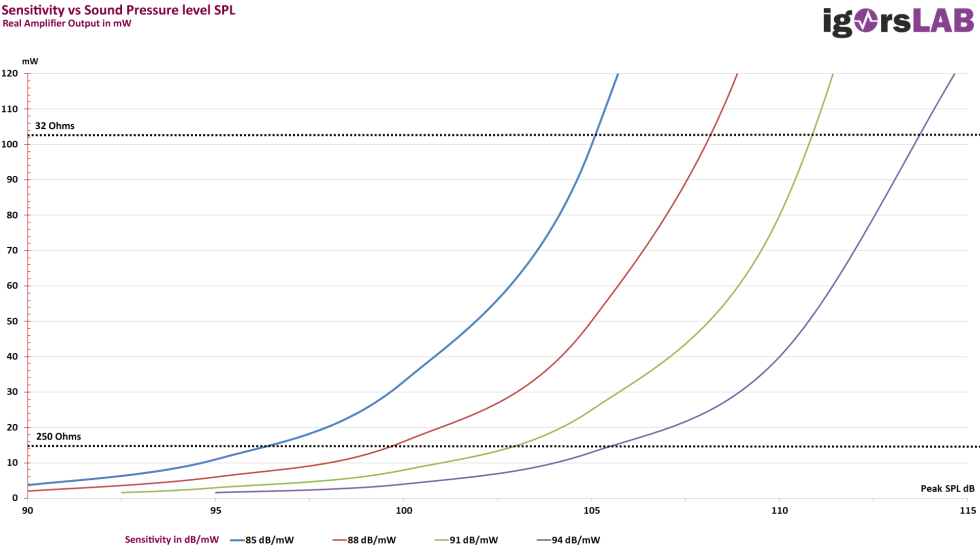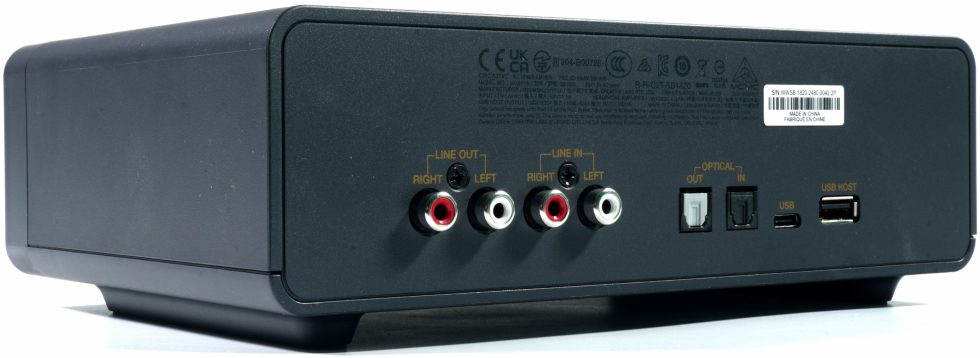Output power and its limits
I have to use the picture with the two devices again, because in the end it is also about the real comparison with confessed products in the more audiophile segment. I already mentioned in the teardown the two Cirrus Logic CS43198 DACs, which support 32-bit/384 kHz PCM playback via USB and can also decode the audio formats DoP128 and DSD256. DNR is specified at 130 dB, and THD+N is 0.00018%. These two DACs are combined with two fully balanced headphone amplifiers, one for each channel. The idea behind separate digital-to-analog conversion and amplification for the left and right channels is to avoid crosstalk and interference. The individual output stages use a very similar multi-stage Xamp design to the Sound Blaster AE-9, but let’s start from the back and see what’s electrically possible at the output. I measured this, by the way, and it comes out about right.
| Asymmetrical | 0.98 Vrms (60 mW) at 16 Ω 1.47 Vrms (65 mW) at 33 Ω 4.11 Vrms (112 mW) at 150 Ω 4.14 Vrms (52 mW) at 330 Ω 4.15 Vrms (29 mW) at 600 Ω |
| Symmetrical | 1.18 Vrms (86 mW) at 16 Ω 1.90 Vrms (109 mW) at 33 Ω 5.86 Vrms (313 mW) at 150 Ω 8.25 Vrms (206 mW) at 330 Ω 8.28 Vrms (114 mW) at 600 Ω |
There are some dedicated desktop amplifiers that offer more brute power, however, the X5 is not a quiet performer, at least in balanced mode. For a Tesla headphone like the T1 or T5, it gets tight asymmetrically with only one power amplifier per channel and there is no real full modulation. With the Amiron Home, on the other hand, it just about works. Creative recommends using the high-gain option for such high-impedance transducers with an impedance of more than 150 Ω to create a bit more air. However, you have to be careful at what point it distorts. If you then overdo it with the gain, you will quickly be punished with the complete shutdown. Clack and off! Then only the separation from the current and a new start helps. But even my magnetostats (Sendy Audio Aiva) at the balanced output would have liked a little more fodder. The HIFIMAN EF400 plays at least a whole class louder and above all more relaxed.
The balanced output offers more power, a significantly larger sound image and improved dynamics. I really strongly recommend using this 4.4mm connector (balanced) for optimal sound. The imaging, micro detail, and soundstage are then particularly well reproduced, especially when higher resolution equipment is paired with the X5. For starters, both outputs deliver an absolutely neutral sound signature with a nicely organic and not too sterile sound impression.
This is what I like, because it is primarily the headphones that decide the sound here, not the amplifier. PCM 32-bit/384 kHz playback and DSD 256 are possible, by the way, and also benefit from the rather neutral signature. The output impedance of 1 Ohm does not pose problems for any transducer then. A very slight background noise can unfortunately also be perceived with extremely sensitive headphones, but only at the unbalanced output. As soon as a light signal is present, this is also forgotten.
For those who can’t understand the output power and impedance, I have a small diagram, where you can see which headphones with which impedance and sensitivity need which output power for a full output:
Sound Impressions
Of course, what you don’t get with most other dedicated DAC/headphone amps is the ability to use the DSP and system-wide 10-band equalizer via software. Personally, however, I reject just that, because it is rather pointless to first buy an expensive device, and then use it to adjust the cheap hardware again. Good headphones and such a DAC do not need these acoustic gimmicks. But in the end, that’s up to everyone. Good to know that it works. About all the normal X-Fi features I have also already philosophized enough and who needs it (or believes to need it), may use that with pleasure. And there’s one more thing I mentioned earlier: the Sound Blaster X5 doesn’t support Super X-Fi technology, which is one of the more pronounced features of Creative’s newer sound cards. The cheaper Sound Blaster X3 and X4 can do this, but the X5 does not. Understand that all you want.
But I already wrote it above that I was especially thrilled by the rather neutral and completely unobtrusive signature. Instead of dry-analytical coldness or seemingly too soft warmth, there is simply nothing that could distract me. Source remains source and the actual signature of the headphones is preserved and promoted. So I can also give praise for once. However, as soon as intervening via DSP, the guest (i.e. me) turns with horror. I just don’t like that. Sorry.
By the way, Bluetooth is implemented bi-directionally for more convenient phone calls, but the codec support is limited to SBC, which immediately puts me off. Also, pairing is a nice waste of time because it almost never worked on the first try. I already wrote something about Bluetooth in the teardown, it is actually better forgotten in this form. Yes, making calls and gaming at the same time is possible, and the phone user can dive into the game at the same time, which is also quite nice. But it’s nothing for music.
Summary and conclusion
If you now miss the whole page with the software, you can gladly repeat all the published articles about the Creative hardware. The required Creative app is no secret and has been discussed many times. It does, even as an app for iOS and Android. Today, I was more interested in the new hardware and the audiophile touch. And there was quite a bit to report on that. Since my review took place after now 5 months of real use and a more intensive disassembly, I simply set other priorities, so as not to repeat everything that can be read online anyway.
To sum up, the Creative Sound Blaster X5 is a versatile and fully featured external USB sound card based on a dual-DAC and dual-balanced headphone amplifier concept. It offers a wealth of connectivity options, including a 3.5mm microphone input jack, Bluetooth connectivity, analog (RCA) and optical (TOSLINK) inputs and outputs, and a USB Type-A audio host port for connecting external USB speakers, headsets, microphones, and wireless receivers. It is compatible with a wide range of devices and you get truly excellent microphone quality. Also, the X5 offers various outputs and supports both low and high gain settings. The accompanying Creative app further expands the usability and versatility of the device.
Despite these positive features, there are also some critical points. The construction of the X5 seems rather cheap and the casing is mostly made of cheap-looking plastic. On top of that, the build quality inside is rather average. Furthermore, the device only supports the SBC codec for Bluetooth and does without the Super X-Fi technology. Another point of criticism is the annoying “crackling” when headphones are plugged in, as well as noise when using high-sensitivity transducers. Although the X5 can satisfactorily drive most factual transducers, it is not the most powerful device compared to desktop-only amplifiers. In addition, the 3.5 mm port is clearly inferior to the 4.4 mm port in terms of sound quality.
| Advantages | Disadvantages |
|---|---|
| Versatile connection options | Cheap-looking look and feel, processing shortcomings |
| Compatible with a wide range of devices | Supports only the SBC codec for Bluetooth |
| Bluetooth connectivity | Does not support Super X-Fi technology |
| Excellent microphone quality | Disturbing “crackling” sound when plugging in headphones |
| Lightweight and therefore easy to transport | Noise when using high sensitivity transducers |
| Supports both low and high gain settings | Output power could be slightly higher |
| Associated Creative app expands the usability and versatility of the device | 3.5mm port (unbalanced) inferior to 4.4mm port (balanced) |
It’s fair to say that the Creative Sound Blaster X5 has its strengths, especially in terms of versatility and connectivity. However, there are also some areas where improvements could be made to optimize the user experience. Visually, haptically and also acoustically. I have to be honest and say that I cannot give a purchase recommendation. Everyone has to decide for themselves where their priorities lie and whether the criticized points are a criterion for exclusion. Unfortunately, the balancing act between audiophile sound solution and gaming demands is not completely successful. It would have been better to spend 50 USD more and really splurge right away. Compromises are always devastating in this price range, because there is also spilling elsewhere. Even below 309 Euros, which I consider too high.




































59 Antworten
Kommentar
Lade neue Kommentare
Veteran
Urgestein
Urgestein
Mitglied
1
1
Mitglied
Mitglied
Urgestein
Urgestein
Mitglied
Mitglied
Urgestein
Mitglied
Urgestein
Urgestein
Urgestein
Urgestein
Urgestein
Alle Kommentare lesen unter igor´sLAB Community →